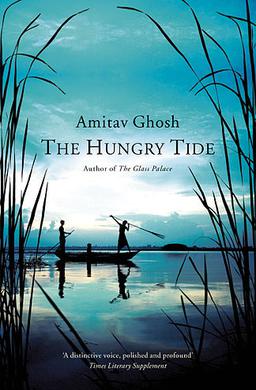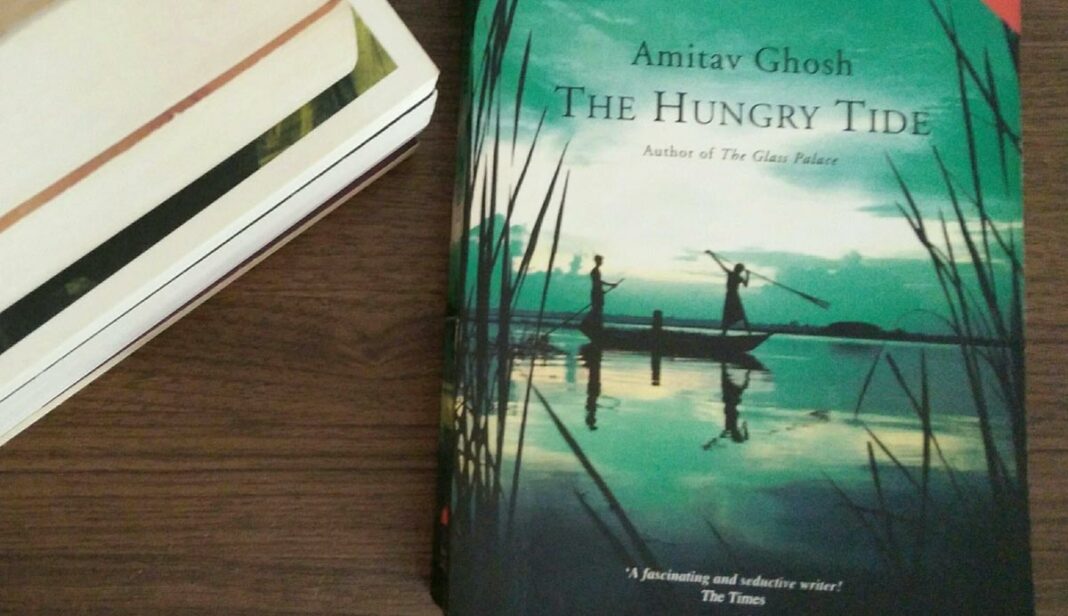Book: The Hungry Tide Author: Amitav Ghosh Genre: Psychological fiction Age: 16+ Publisher: Harper Collins Publishers India Pages: 403 Published on: 2005
Published in the year 2005, Amitav Ghosh’s novel “The Hungry Tide” explores multiple issues while building a subtle plot taking into account the disasters and hardships faced by the people of Sundarbans. Hunger remains as the pivotal concept that shapes not just the earthlings but also of nature in the form of animals and calamities. His implausible description of storms and the tides that demolishes human lives, and shatters the existing linguistic, socio-cultural boundaries between man is interesting. The war between nature and man takes shape in the form of tempest and man fighting against it to survive. While, Ghosh sticks to the universal idea of the superiority of nature over mankind, he also portrays the motherly instincts of nature and the pity she takes on her children.

The three protagonists of the novel are Piya; an American who has arrived to the Sundarbans in all hopes to research about the habituation of the Irrawaddy Dolphins, Kanai; the nephew of Nirmal and Nilima whose arrival builds the atmosphere and sets the tone of the gale and Fokir; a fisherman who represents nature in every form, his voice is the voice of nature trying to communicate with the mortals. The novel treats nature as its cardinal theme. It’s nature that controls human lives and takes the form of Bon Bibi; a supernatural God deciding when to toss and create human lives. It is in this tidal country that religion is challenged in the way that the God worshipped and verses (mantras) read is an amalgamation of Hindu and Muslim principles. The custom of venerating the idol of Bon Bibi at Garjontola is truly mesmerising as Horen reads out scripts in Arabic with repeated mentions of Allah and challenging it stands the idol of Bon Bibi (we are aware of the fact that Muslims don’t have the consuetude of idol worshipping). Facts as such confuses Kanai as he lives in Delhi amidst a mass of educationally evolved human beings who gnaws at the question of religious superiority. However, for Piya who has a little idea about religion and whose presence in the island is like a suckling infant who is mesmerised and grapples with everything that she comes across.
Ghosh has treated the tidal country as an altogether different world that perhaps geographically has no connection with the rest of the universe. Surrounded by water on all sides, the people who lands up in these islands are themselves refugees with no particular identity of their own. What binds them together is faith on destiny and the acceptance of the eternal doom of death that lingers in the air. “Love” here trespasses all social norms and is acknowledged as something that rises above all possible explanations and bondages. Fokir disentangles Piya from the toxic, masculine forest guard and this can be connected with the myth of Bon Bibi coming to the rescue of the feeble Duk hey. Bon Bibi as a mental image can be located as present within various characters of the novel. Perhaps it’s the tendency of humans to behave in a godly, pure, selfless way in certain situations and this culminates as the goddess; BonBibi. Piya’s affection towards Fokir rises on a different note as her emotions flowers, lying vulnerable to the unlettered man.
Piya and Fokir have nothing in common, neither can interpret each other’s words but the song that Fokir sings strikes a chord in Piya’s heart although she is completely clueless about what he sings. She cries “‘Sing,’ she said. ‘Bon Bibi – Dukhey – Dokkhin Rai. Sing’”. The human tendency to cojoin two similar figures is something that nature resents. Kanai as a sophisticated, urban man who converses with Piya in English is considered to be a perfect match for her. However, the possibility of unlike nature attracting each other as magnets takes a realistic turn with Piya’s acceptance of her budding feelings for Fokir.
“Their bodies were so close, so finely merged, that she could feel the impact of everything hitting him, she could sense the blows raining down on his back”.
As, nature has a tendency to demolish abnormal activities; just like the storms blowing away dams and human settlements, quite similarly the love that flowers between Horen and Kusum, and Piya and Fokir is destroyed momentarily. One must die and let the other survive. As Fokir shields Piya from the ruthless storm and uses his body to shelter her from the flying bricks and trees and ultimately succumbs, he once again takes the form of BonBibi and protects her at all costs. Ghosh quotes Rilke to explain these unnatural feelings which has no justification:
“Look, we don’t love like flowers
with only one season behind us; when we love,
a sap older than memory rises in our arm s. O girl,
it’s like this: inside us we haven’t loved just someone
in the future, but a fermenting tribe; not just one
child but fathers, cradled inside us like ruins
of mountains, the dry riverbed
of former mothers, yes, and all that
soundless landscape under its clouded
or clear destiny- girl all these came before you.”
Where the question of rebellion thrives, the novel is a proof of how ordinary people are puppets in the hands of the government. The government and the police forces can be studies in the light of the supernatural beast, the devil Dokkhin Rai who pounces on man and tears them apart by using his sharp claws and teeth. The terrific means of forcibly depriving the people of Morichjhapi from the necessary requirements and exploiting the women is indeed something that is demonic, selfish and cruel. The people of Morichjhapi like Kusum are alive because of the fire of rebellion that kindles in their tiny hearts and thus they fight. The question that probes is that if Nilima’s actions in the light of the rebellion by siding with the government is selfish or realistic?
Thus, the novel The Hungry Tide floods with superstitious beliefs, revolts, deaths and gives us an account of various forms of love. While the ending is kept open allowing the readers to draw their own conclusions but it remains as a remarkable work celebrating the life led by the people of Sundarbans. The climatic change, the hunting of innocent beasts, and other concerns are all a part of the plot. Henceforth, it’s true that “The Hungry Tide” is:
“An intriguing tale of history, folklore, ecology, migration, love and grief.” (Independent)
- The Challenge Of Cyber Theft And It’s Impact On National Security

- When Honest Feel Harassed: Why India’s High Net-Worth Individuals (HNIs) Are Losing Faith in the System

- India | Readying For Wars

- MRO Monopoly – Is India Sleepwalking Into It Too, Indigo Style?

- Click, Pay and Get Cheated: How Amazon India’s Fake Seller Network Is Looting Innocent Consumers

- Adani’s Next Airspace Play: Basraon’s FSTC in Sights




















